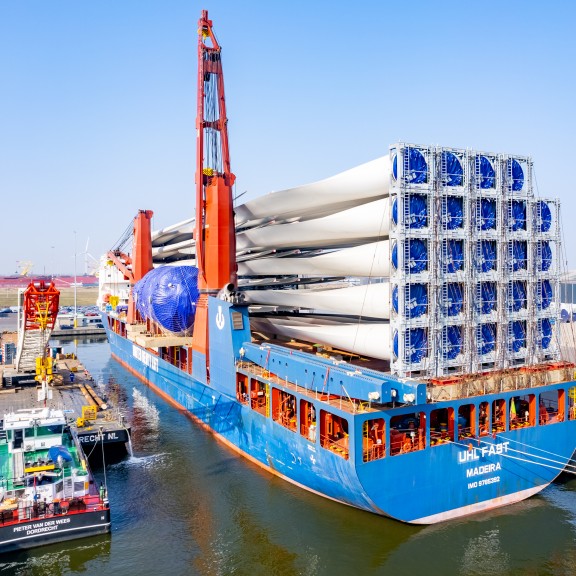
Windplanblauw and the logistic journey from the port of Amsterdam
The third wind farm to be facilitated from TMA Logistics in the Amsterdam port after Westermeerwind and Fryslân, Windplanblauw involves 61 brand-new wind turbines around the cities of Lelystad and Dronten.
A large share of the parts needed to build this farm are being transhipped and stored in the Amerikahaven port. Involving 227 tower parts and 111 blades, this is a highly complex logistical process, as Michael van Toledo, General Manager at TMA Logistics, explains.
Complex logistics
There was lots of heavy traffic moving to and from the quays of TMA Logistics in early March to mid-April. In addition to business as usual – the transhipment of containers, breakbulk, Ro/Ro and intermodal transport – the terminal was accommodating countless wind turbine parts, such as tower parts, nacelles, generators and giant blades. Made in factories in Vietnam, Turkey and China, the parts were brought to Amsterdam by seagoing vessels.
“Having so many vessels arriving around the same time was a major challenge,” says Michael. “It was a meticulous task to ensure all the parts from the vessels went to the correct place. The blades, for example, are aligned in threes so they have to be kept together. But the complexity applies to the vessels too. The wind turbine parts are fastened with chains or even welded in place to ensure safe transport. Back in the ports, it then takes around a day to unfasten these huge components. Thankfully we have a lot of experience in similar projects and know how to handle large vulnerable parts with the utmost care.”
By road and water to the Flevopolder
After beings stored at the terminal, the tower parts are transported to the Flevopolder via inland shipping. With two to three parts per vessel, this totals some 90 inland vessels for this project alone. The blades are transported to the wind farm by road. Michael: “These blades are 80 metres long and everything has to be very carefully organised. Just moving them around the terminal required us to remove various lamp posts in order that the blades could be rotated. We are proud with the way everything turned out in this respect and that the blades could then be transported to Lelystad on the A5 motorway. This took place at night in order to minimise any disruption to normal traffic. The transport company Van der Vlist had arranged this with the government authorities weeks in advance to ensure the roads were ready. This included lengthening the roundabouts in the port to allow the trucks with the blades to pass.”
Challenges in space and staff
Everything revolves around space with a project like this, says Michael: “Space in the port is at a premium so we have to use it optimally. The blades are great windcatchers, for instance, so to prevent damage they cannot be stacked. We had assumed that a storage area of 6.5 hectares would be needed for this project but we’re already at over 11. Thankfully we have the space available.” Another major challenge is to find the right staff such as crane drivers, truck drivers and people for the ship hulls. “Our fast growth has accelerated this problem and we’re already looking at what expertise we’ll need in a few years. We recently launched a dedicated website (www.werkenindeamsterdamsehaven.nl) to attract more people.”
Collaborating partners
TMA Logistics is working with Vestas and Van der Vlist on this major project. Vestas is manufacturing the turbines and realising their installation on site. Van der Vlist is responsible for the majority of road transport of the wind turbine blades. Michael is pleased with both collaborations: "Projects of this scope can only be realised through cooperation. They also demand a flexible attitude because not everything will go as planned. Working with these parties has been a fine experience and we complement also each other professionally.”
About Windplanblauw
Windplanblauw is being developed in the north-west corner of the polder of Flevoland, in the municipalities of Lelystad and Dronten. It involves the replacement of 71 wind turbines with 61 larger ones. The new turbines have a greater capacity and the amount of energy generated will be equivalent to the annual power consumption of one million households. Renewable energy is one of the pillars of a sustainable energy and industrial system. To preserve its position as an energy port in the future, our region has long been investing in the offshore wind market with regards to both installation & production and maintenance. The future wind farm is in line with the ambition of the Dutch government to generate 70% of electricity via renewable sources by 2030.